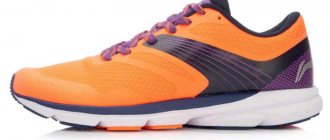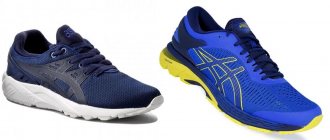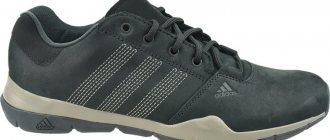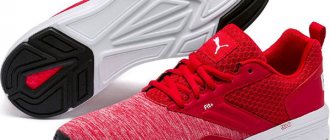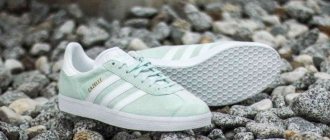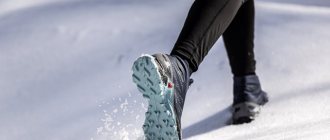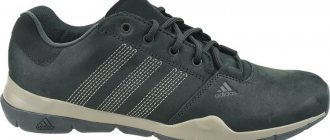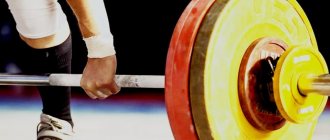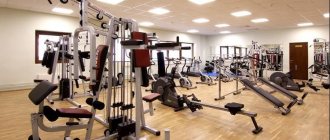The feet are a part of the body that receives tremendous stress throughout the day, as the soles serve as support during walking, running, strength training and normal standing. Pronation and supination ensure proper functioning of the foot.
Thanks to the mechanisms of pronation and supination, the foot is cushioned, the impact on the surface is softened, and balance is maintained. This is taken into account in the production of sports shoes. It is recommended to select sneakers taking into account the type of pronation.
What is pronation?
When running, your leg joints experience increased stress. When contacting a hard surface, the foot suffers a strong blow, which is transmitted to the knee, hip joint and lower back. At this moment, the natural shock absorption mechanism is activated, which absorbs the force of the impact. At the same time, the foot becomes flatter, and its arch turns inward. This correct placement of the foot during movement is called pronation.
There are hyperpronation, hypopronation and neutral pronation.
Overpronation is characterized by a strong inward displacement of the arch of the foot during movement. In this case, a decrease in the longitudinal arch of the foot is observed. Overpronation often accompanies flat feet. With hypopronation, the arch of the foot moves outward when moving. Both deviations of the foot from the neutral position do not provide adequate shock absorption during movement, which increases the risk of injury. With neutral pronation, the natural shock absorption mechanism works properly.
FAQ
How to choose running shoes in a store?
+
Don't rush to take the first shoe you like. First, try on several pairs, walk around in them, and buy those in which you feel completely comfortable. Try on wearing socks for classes.
If the model does not suit your type of pronation, you can correct the discrepancy with anatomical insoles made for your foot type.
There are synthetic running socks on sale that provide thermoregulation, wick away moisture, and prevent the formation of calluses. For short distances we recommend short socks, for long distances we recommend compression socks that improve blood circulation.
How to care for running shoes?
+
To ensure that your sneakers retain their performance characteristics longer, take proper care of them:
- After a run, take out the insoles, dry and air them.
- Use foot deodorants to prevent unpleasant odors and the development of fungus.
- Regularly clean the top with a brush and treat with a water-repellent spray.
- Wash sneakers by hand in warm water with liquid detergent, removing the laces and insoles. Rinse thoroughly until the water runs clear. Dry on the balcony.
- When machine washing, place shoes in a mesh bag with foam strips around the perimeter.
How to lace running shoes?
+
There are many original and classic lacing options, but for running it is best to use the traditional crossover lacing method.
Some models feature new lacing technology. The manufacturer covers the top with a dense mesh. Every hole in it is suitable for lacing. Thanks to this method, the sneakers easily adapt to the characteristics of the foot and fit snugly on the leg.
How much weight should running shoes have?
+
The weight of training running shoes ranges from 280-340 grams (one sneaker). Models for competitions weigh less - 180-280 grams. For running on difficult terrain, products weighing at least 330 grams are in demand.
The larger the size, the heavier the shoe (and vice versa). A change in weight of even 100 grams significantly affects the speed and comfort of running, but do not go for the lightest running shoes. At long distances they are ineffective, and may also lack shock-absorbing properties.
Is it possible to run with flat feet?
With flat feet, the shape of the foot is deformed, as a result of which its shock-absorbing ability during movement is significantly reduced. This places increased stress on the leg joints and spine and increases the risk of injury. One of the measures for the prevention and treatment of flat feet is moderate physical activity. Among them is gentle running.
Doctors are confident that flat feet should not be a reason to give up this type of sports.
After all, running strengthens muscles and improves blood circulation, which is especially important when treating an illness. The main thing here is to choose special running shoes.
Underpronation
The most important feature of hypopronation is the lack of arching of the foot. The leg falls heavily on the outer part of the ankle. The shock load is not distributed effectively enough, and the musculoskeletal system begins to suffer from this. The main load falls on the small fingers. The sneakers will be worn out excessively on the outside.
Best running shoes for overpronated feet
Choosing the wrong running shoes for people with overpronation can lead to knee and lower back pain and various types of injuries while moving. Special stabilizing running shoes for running will help avoid this. Such models perfectly hold the foot and absorb shock loads that occur when it comes into contact with a hard surface.
Well-known sports brands produce lines of special stabilizing shoes for people with overpronation.
Asics Gel-Kayano 27
Running shoes from the largest Japanese sportswear and footwear manufacturer Asics are designed to support overpronated feet during training on hard surfaces. The silicone wave-shaped insert on the heel allows you to smooth out the force of impact during movement and evenly distribute the load. The midsole consists of materials of varying degrees of density, which ensures stabilization of the position of the foot when running and does not allow it to roll inward excessively. An EVA foam insole provides extra cushioning as you move.
The upper of the sneakers is made of lightweight and breathable Jacguard Mesh, which prevents your feet from overheating even in the hottest weather.
Pros:
- strong and durable;
- good ventilation;
- ensuring safety and comfort while driving.
Minuses:
- somewhat heavy for ultra-long distances;
- high price.
Asics running shoes can be safely recommended to beginners and experienced runners.
They secure the foot well and reduce the impact force. But for ultra-fast races and long distances they are too heavy.
Mizuno Wave Inspire 17
Running shoes from the Japanese manufacturer Mizuno are made using updated Double Fan Shaped Wave technology. It prevents the inside of the foot from flattening. The shoes provide excellent cushioning when moving and can be used by people who overpronate. The top of the products is a breathable mesh material. This makes them very comfortable to use in hot weather.
The midsole has excellent elasticity and softness.
Pros:
- excellent fit;
- easy move;
- good grip on the surface.
Minuses:
- a little harsh in the toe area;
- somewhat heavy.
Running shoes from Mizuno have a medium level of stabilization that provides an elastic ride.
Suitable for daily runs.
Asics GT-2000 9
The ninth version of the GT-2000 series stability sneakers from the Japanese company Asics is presented in lightweight and comfortable models with a one-piece upper for a better fit of the foot. Excellent cushioning is provided by gel inserts inside in the back and front. The use of a special silicone material in the midsole makes the product soft and provides additional support when landing.
Pros:
- light and comfortable;
- fits the leg well;
- perfectly absorb shocks when moving;
- good grip on the surface.
Minuses:
- movable tongue;
- The outdated Trusstic system under the central part of the sole is felt during the run.
Practical stability running shoes from Asics are perfect for beginner runners and anyone who needs more protection for their joints during regular runs.
Nike Air Zoom Structure 23
Running shoes from the American sporting goods corporation Nike are designed for regular training of pronator runners. The soft foam midsole and Air Zoom units in the forefoot help absorb shock as you move. The woven heel provides a comfortable fit and good heel stabilization.
The top of the products is made of breathable, dense material that ensures good air circulation.
Pros:
- soft roll;
- wide base;
- fitted top;
- soft and comfortable;
- durable and wear-resistant sole.
Minuses:
- The soft sole may become deformed over time.
Running shoes from Nike provide good support for your feet and relieve stress on your feet while moving.
They are perfect as a training model for experienced runners and people with flat feet.
Hoka One One Arahi 5
One of the lightest models of the French brand Hoka One One was specially created for people with structural features of the foot - hyperpronation. The peculiarity of this model is the presence of a voluminous and lightweight sole, which provides maximum shock absorption when moving. The difference between the heel and toe is small - only 5 mm. This sole structure ensures a natural foot position when running. The top of the product is made of light and elastic fabric. Due to this, the sneakers fit well and fix the foot.
The rubber outsole has pods in areas prone to premature wear.
Pros:
- wear-resistant sole;
- light and comfortable;
- very soft.
Minuses:
- high price;
- designed for wide soles.
Lightweight and comfortable, Hoka One One is perfect for long-distance running.
Feet in such sneakers do not get tired for a long time. But they are not suitable for speed racing.
Adidas Solarboost 3
A running model from the German company Adidas was created for people with a normal level of pronation. But it can also be used by people with problems with proper foot placement when running long distances. The Boost midsole is made from polyurethane foam, evenly distributing the load on the foot during movement and providing excellent cushioning. And rigid inserts on the sides prevent lateral twisting. The LEP system at the base of the outsole activates energy return, which helps your feet feel less tired even when running very long distances.
A special Control Rail structure in the midsole provides stability to the foot while moving.
Pros:
- light and comfortable;
- bright design;
- good shock absorption.
Minuses:
- a hard top that may be uncomfortable for some runners;
- do not provide the proper level of ventilation.
Running shoes from Adidas are designed for long-distance running on hard surfaces at a comfortable pace.
They are suitable for athletes with beginner and intermediate levels of training.
Saucony Guide 14
This running model from the oldest sports brand Saucony is designed for people with excessive pronation. The sole of the product is made using three-component Formfit technology: a comfortable insole, elastic Everun material and a special layer that follows the shape of the foot. The insole is impregnated with an antibacterial composition to prevent the appearance of unpleasant odors. The top of the products is made of breathable material. The inner lining is created using HydraMAX Collar Lining technology, which ensures moisture removal during movement and maintains a comfortable microclimate inside.
Pros:
- good grip on the surface;
- light and soft;
- antibacterial insole;
- good ventilation.
Minuses:
- high price.
Lightweight and stylish running shoes from Saucony are perfect for regular long-distance runs.
New Balance Fresh Foam 880v11
The running model from the American manufacturer of sportswear and footwear New Balance is designed for training and long-distance running. They are light, soft and elastic. The Fresh Foam midsole, consisting of clusters of different densities, is responsible for shock absorption. The rubber outsole with separate inserts provides good grip on the surface. The upper of the model is made of jacquard mesh, allowing the skin to breathe freely.
Pros:
- good shock absorption;
- smooth landing;
- large selection of colors;
- light and comfortable.
Minuses:
- high price;
- poor cushioning of the metatarsal zone.
Sneakers from New Balance are suitable for regular daily runs.
They will be appreciated by those athletes who work hard to improve their technology.
Hoka One One Gaviota 3
A model from the French brand Hoka One One, designed for people with overpronation, can be used for races at any distance. It combines good foot support with soft and springy cushioning. Protection against excessive deflection of the arch of the foot is provided by the special design of the J-Frame model. The flat surface of the sole is responsible for stability and stability when moving. The top of the products is made of lightweight mesh material that provides a good level of ventilation.
Pros:
- spring well;
- comfortable fit;
- durable.
Minuses:
- laces are too long;
- high price.
Hoka One One running shoes are good for running and walking on hard surfaces.
Helpful information
Size selection
These comfortable running shoes fit securely in place and have a little room in the toe area. When trying on, be guided by your own feelings. Make sure that your leg does not compress or dangle in different directions.
It is important to determine your size correctly. To do this, measure your foot. Since your legs swell in the evenings, take measurements in the morning to ensure a tight fit. If your shoes feel tight at the end of the day, try them on before going to bed.
- Place two sheets of paper on a flat floor and place your bare feet on them.
- Use a pencil to outline the outline of your feet (hold it strictly vertically).
- Using a ruler, measure the length of your leg from the center of your heel to the tip of your big toe.
- Add 5 mm to the resulting figure and get the leg size in cm.
Since there are several systems of shoe sizes, you will have to navigate according to the correspondence table of American, European and Russian brands:
Please note that some manufacturers have different sizes from standard ones, so find out which chart the company you need uses.
How often should you change your running shoes?
Roskachestvo specialists recommend changing shoes after an athlete covers 500-1000 km in them. This means that if you run 3 km daily, then after a year you should think about a new purchase.
External signs of wear are:
- asymmetry of the sole of one foot in relation to the other,
- protrusions in the toe area in the toe area,
- cracks on the tread.
Even if the model looks good, most likely, its shock absorption and fixing properties have deteriorated during wear. And this can lead to injury.
